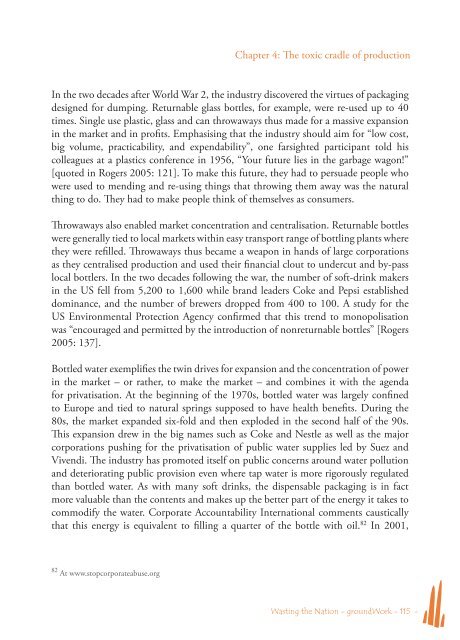Wasting the Nation.indd - Groundwork
Wasting the Nation.indd - Groundwork
Wasting the Nation.indd - Groundwork
Create successful ePaper yourself
Turn your PDF publications into a flip-book with our unique Google optimized e-Paper software.
Chapter 4: The toxic cradle of productionIn <strong>the</strong> two decades after World War 2, <strong>the</strong> industry discovered <strong>the</strong> virtues of packagingdesigned for dumping. Returnable glass bottles, for example, were re-used up to 40times. Single use plastic, glass and can throwaways thus made for a massive expansionin <strong>the</strong> market and in profits. Emphasising that <strong>the</strong> industry should aim for “low cost,big volume, practicability, and expendability”, one farsighted participant told hiscolleagues at a plastics conference in 1956, “Your future lies in <strong>the</strong> garbage wagon!”[quoted in Rogers 2005: 121]. To make this future, <strong>the</strong>y had to persuade people whowere used to mending and re-using things that throwing <strong>the</strong>m away was <strong>the</strong> naturalthing to do. They had to make people think of <strong>the</strong>mselves as consumers.Throwaways also enabled market concentration and centralisation. Returnable bottleswere generally tied to local markets within easy transport range of bottling plants where<strong>the</strong>y were refilled. Throwaways thus became a weapon in hands of large corporationsas <strong>the</strong>y centralised production and used <strong>the</strong>ir financial clout to undercut and by-passlocal bottlers. In <strong>the</strong> two decades following <strong>the</strong> war, <strong>the</strong> number of soft-drink makersin <strong>the</strong> US fell from 5,200 to 1,600 while brand leaders Coke and Pepsi establisheddominance, and <strong>the</strong> number of brewers dropped from 400 to 100. A study for <strong>the</strong>US Environmental Protection Agency confirmed that this trend to monopolisationwas “encouraged and permitted by <strong>the</strong> introduction of nonreturnable bottles” [Rogers2005: 137].Bottled water exemplifies <strong>the</strong> twin drives for expansion and <strong>the</strong> concentration of powerin <strong>the</strong> market – or ra<strong>the</strong>r, to make <strong>the</strong> market – and combines it with <strong>the</strong> agendafor privatisation. At <strong>the</strong> beginning of <strong>the</strong> 1970s, bottled water was largely confinedto Europe and tied to natural springs supposed to have health benefits. During <strong>the</strong>80s, <strong>the</strong> market expanded six-fold and <strong>the</strong>n exploded in <strong>the</strong> second half of <strong>the</strong> 90s.This expansion drew in <strong>the</strong> big names such as Coke and Nestle as well as <strong>the</strong> majorcorporations pushing for <strong>the</strong> privatisation of public water supplies led by Suez andVivendi. The industry has promoted itself on public concerns around water pollutionand deteriorating public provision even where tap water is more rigorously regulatedthan bottled water. As with many soft drinks, <strong>the</strong> dispensable packaging is in factmore valuable than <strong>the</strong> contents and makes up <strong>the</strong> better part of <strong>the</strong> energy it takes tocommodify <strong>the</strong> water. Corporate Accountability International comments causticallythat this energy is equivalent to filling a quarter of <strong>the</strong> bottle with oil. 82 In 2001,82 At www.stopcorporateabuse.org<strong>Wasting</strong> <strong>the</strong> <strong>Nation</strong> - groundWork - 115 -
















